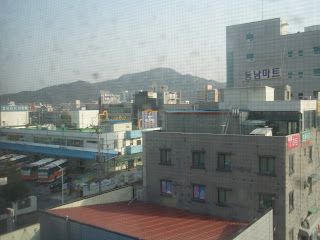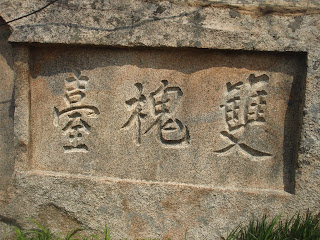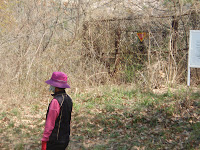Satuurday we decided that we would climb the mountain outside of Taean.
 This is the view of the mountain from my hotel room. I can't find where I wrote down the name, but when I find out, from one of the guys who climbed it with me, I will edit the blog and add it here.
This is the view of the mountain from my hotel room. I can't find where I wrote down the name, but when I find out, from one of the guys who climbed it with me, I will edit the blog and add it here.  Whenever you hike in the countryside of Korea you may happen upon these signs. Here there is more reason than most and I will address that a little further down.
Whenever you hike in the countryside of Korea you may happen upon these signs. Here there is more reason than most and I will address that a little further down.  As we hiked up toward the top we were surrounded by cherry trees. I have so many pictures of cherry trees here and on othe rmountains that I will only post this one here with the Japanese magnolia in the foreground. I intended to do a post of just pictures of cherry trees, but I won't do it for several reasons. One I am running out of time, two they would get monotonous and three the pictures universally fail to do the cherry trees justice. Around the main building on the base on Friday the blossoms were falling like snow, and like the snow in Cold Lake were swirling around the road. I could not take a picture of that, so I will not post many other pictures of the cherry blossoms and trees.
As we hiked up toward the top we were surrounded by cherry trees. I have so many pictures of cherry trees here and on othe rmountains that I will only post this one here with the Japanese magnolia in the foreground. I intended to do a post of just pictures of cherry trees, but I won't do it for several reasons. One I am running out of time, two they would get monotonous and three the pictures universally fail to do the cherry trees justice. Around the main building on the base on Friday the blossoms were falling like snow, and like the snow in Cold Lake were swirling around the road. I could not take a picture of that, so I will not post many other pictures of the cherry blossoms and trees.  Here is a picture of the 'town' of Taean looking back down the mountain and toward the yellow sea. The range, where we work is about 50 kilometers toward the upper right of that photo, but you can't see it. Neither can you see China which is about 100 miles in the same direction across the yellow sea.
Here is a picture of the 'town' of Taean looking back down the mountain and toward the yellow sea. The range, where we work is about 50 kilometers toward the upper right of that photo, but you can't see it. Neither can you see China which is about 100 miles in the same direction across the yellow sea. Who's the fat guy leaning on the marker for the top of the mountain? Actually, I didn't get a picture but a lot of the Koreans who had made it to the top not only took their picture here, but they had a soju party on picknick blankets at the foot of the rock this is on. I can't imagine trying to descend this mountain after drinking.
Who's the fat guy leaning on the marker for the top of the mountain? Actually, I didn't get a picture but a lot of the Koreans who had made it to the top not only took their picture here, but they had a soju party on picknick blankets at the foot of the rock this is on. I can't imagine trying to descend this mountain after drinking. This is an older inscription at the top of the mountain. This and a relic I will discuss below date from an older period when the Chinese dominated this area. The script in the inscription is of chinese characters, but in the older Korea language. Now Koreans use a script called Hangul, which is alphabetic as opposed to character writing in the Chinese. The letters in Hangul are grouped into syllables which make them appear like Chinese characters (and syllable spacing and word spacing typically do not differ). It seems to me Hangul is a lot easier to learn.
This is an older inscription at the top of the mountain. This and a relic I will discuss below date from an older period when the Chinese dominated this area. The script in the inscription is of chinese characters, but in the older Korea language. Now Koreans use a script called Hangul, which is alphabetic as opposed to character writing in the Chinese. The letters in Hangul are grouped into syllables which make them appear like Chinese characters (and syllable spacing and word spacing typically do not differ). It seems to me Hangul is a lot easier to learn. Saw this lady as we climbed back down. She passed us and was moving a lot faster than we were, but she had on a mask. I couldn't figure why you would have a mask on while you were hicking on a mountain in a national park, but she must have had here reasons. This was the cleanest air we encountered outside of the sea breezes.
Saw this lady as we climbed back down. She passed us and was moving a lot faster than we were, but she had on a mask. I couldn't figure why you would have a mask on while you were hicking on a mountain in a national park, but she must have had here reasons. This was the cleanest air we encountered outside of the sea breezes.Here is the reason that there were more land mine signs on this mountain than in your average Korean mountain hike. There is a large military facility on this mountain that is important in deterring North Korean attacks. When we were here is was still soon after the Chongnam was sunk and we thought tensions were high, but the Koreans seem to have gotten used to living with the tensions between the Koreas and did not seem overly concerned. I learned a little more about this toward the end of my stay, but I will blog that in good time. Anyway, you should know that South Korea, R.O.K., is on high military alert all the time and it colors a lot of the life in this area.
 I wanted to post the pictures of this monastery and buddhist relic from the descent, because it was more impressive to me to see as we were coming out of the wooded trail (as opposed to the parking lot). This is the view as you descend around a small waterfall to a shelter around a relic of buddhism from around the 6th centtury.
I wanted to post the pictures of this monastery and buddhist relic from the descent, because it was more impressive to me to see as we were coming out of the wooded trail (as opposed to the parking lot). This is the view as you descend around a small waterfall to a shelter around a relic of buddhism from around the 6th centtury. Here is the buddhist relic, the Taean Maae Samjonbul. Samjonbul, I am reliably told means "three Buddhas" but that is inaccurate, since only the middle figure is actually Buddha or as the explanatory sign (in full English unlike most things in Taean) calls it a Boddhisatva. The other two figures are actually of Buddhist priests as identified by the robes they are wearing. It is unique in that the Boddhisatva is not normally depicted as smaller than ancillary figures. The guy in the next picture told us that this was very similar to the common style of the Norther Qi Dynasty in China in approximately the 6th century and that is the basis for the dating of the carving to that time.
Here is the buddhist relic, the Taean Maae Samjonbul. Samjonbul, I am reliably told means "three Buddhas" but that is inaccurate, since only the middle figure is actually Buddha or as the explanatory sign (in full English unlike most things in Taean) calls it a Boddhisatva. The other two figures are actually of Buddhist priests as identified by the robes they are wearing. It is unique in that the Boddhisatva is not normally depicted as smaller than ancillary figures. The guy in the next picture told us that this was very similar to the common style of the Norther Qi Dynasty in China in approximately the 6th century and that is the basis for the dating of the carving to that time.  The guy spoke the best English of anyone in Taean that did not work on our project and was very welcome for his insights. I have to believe he doesn't get a lot of English speaking visitors. The building around the carving was built by the Korean Government in around 2002 (or at least it was refurbished then) and it is not a Buddhist temple, although at the the time we were there some offerings were on a table in front of the carving.
The guy spoke the best English of anyone in Taean that did not work on our project and was very welcome for his insights. I have to believe he doesn't get a lot of English speaking visitors. The building around the carving was built by the Korean Government in around 2002 (or at least it was refurbished then) and it is not a Buddhist temple, although at the the time we were there some offerings were on a table in front of the carving. Next door, however was a Buddhist temple and while we were walking around it a service must have been going on because we could hear rhythmic bells and what sounded to me like the rolling of prayer wheels. While I was curious to see what was going on, I didn't think it was right to intrude as a tourist. Here are some of the pictures on the side of the Temple which was built within the last 10 years or so. The guys with me let me know it was not there on our original install back in 1993. These pictures appear to me to be from the life of Buddha and go all the way around the temple. They do not look to be protected from the weather at all so I wonder if they won't fade after a few years.
Next door, however was a Buddhist temple and while we were walking around it a service must have been going on because we could hear rhythmic bells and what sounded to me like the rolling of prayer wheels. While I was curious to see what was going on, I didn't think it was right to intrude as a tourist. Here are some of the pictures on the side of the Temple which was built within the last 10 years or so. The guys with me let me know it was not there on our original install back in 1993. These pictures appear to me to be from the life of Buddha and go all the way around the temple. They do not look to be protected from the weather at all so I wonder if they won't fade after a few years.  Here's a wider angle view. the building housing the carving is behind the trees on the right of this pictue. Those colorful lamps are stretched all around the compound where the temple (and a building that I believe to be the attendant monk's or priest's living quarters) sits. It is all set up like a public park and while I believe that Korea does not have a national religion (the people are around 50% Christian, mostly presbyterian from the looks of things) I think that this is a government park like the rest of the mountain and they allowed the monks to build the temple here.
Here's a wider angle view. the building housing the carving is behind the trees on the right of this pictue. Those colorful lamps are stretched all around the compound where the temple (and a building that I believe to be the attendant monk's or priest's living quarters) sits. It is all set up like a public park and while I believe that Korea does not have a national religion (the people are around 50% Christian, mostly presbyterian from the looks of things) I think that this is a government park like the rest of the mountain and they allowed the monks to build the temple here. We never did figure this out. In a garden on the side of the temple some of the trees (which look like young fruit trees to me, but I don't know what fruit) had bottles on them. These are plastic 1.5 liter bottles of soft drinks or maybe soju and we couldn't figure out why they were there and the English speaking guy whoul could have answered our questions was far away.
We never did figure this out. In a garden on the side of the temple some of the trees (which look like young fruit trees to me, but I don't know what fruit) had bottles on them. These are plastic 1.5 liter bottles of soft drinks or maybe soju and we couldn't figure out why they were there and the English speaking guy whoul could have answered our questions was far away. This is the cooking area. Charcoal cookstoves and the pots are where they ferment Kimchee. I think I have a lot of pictures of Kimchee pots, but I don't think I will post on them. Also there were two dogs in the back, one a poodle-looking tiny thing and the other a "Jindo" dog on a rope tied to his dog house. I mention this because I need to do a post of the new prevalance of dogs in Korea, no that they no longer eat them a lot, but you probably haven't read this far anyway.
This is the cooking area. Charcoal cookstoves and the pots are where they ferment Kimchee. I think I have a lot of pictures of Kimchee pots, but I don't think I will post on them. Also there were two dogs in the back, one a poodle-looking tiny thing and the other a "Jindo" dog on a rope tied to his dog house. I mention this because I need to do a post of the new prevalance of dogs in Korea, no that they no longer eat them a lot, but you probably haven't read this far anyway.




No comments:
Post a Comment